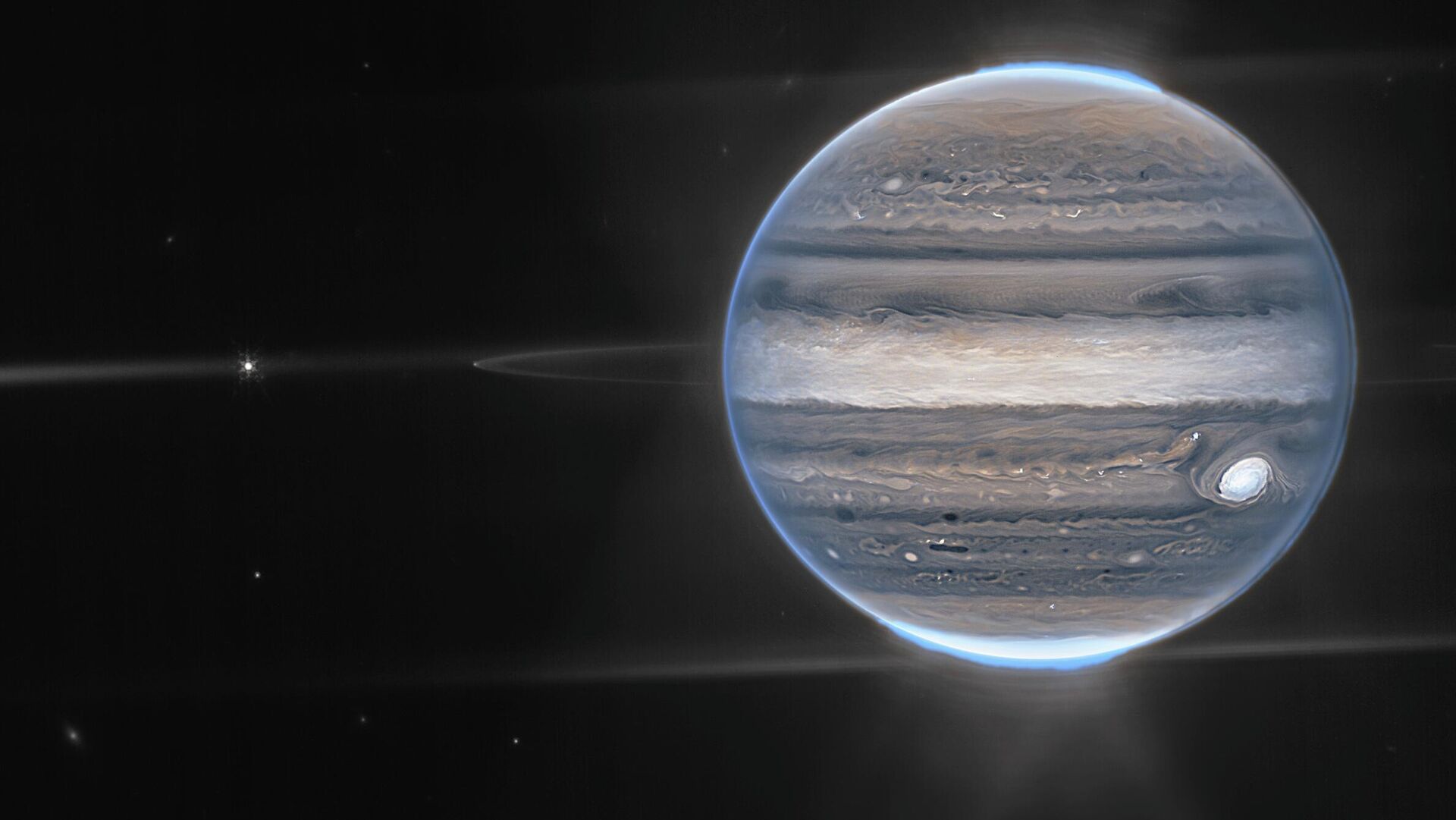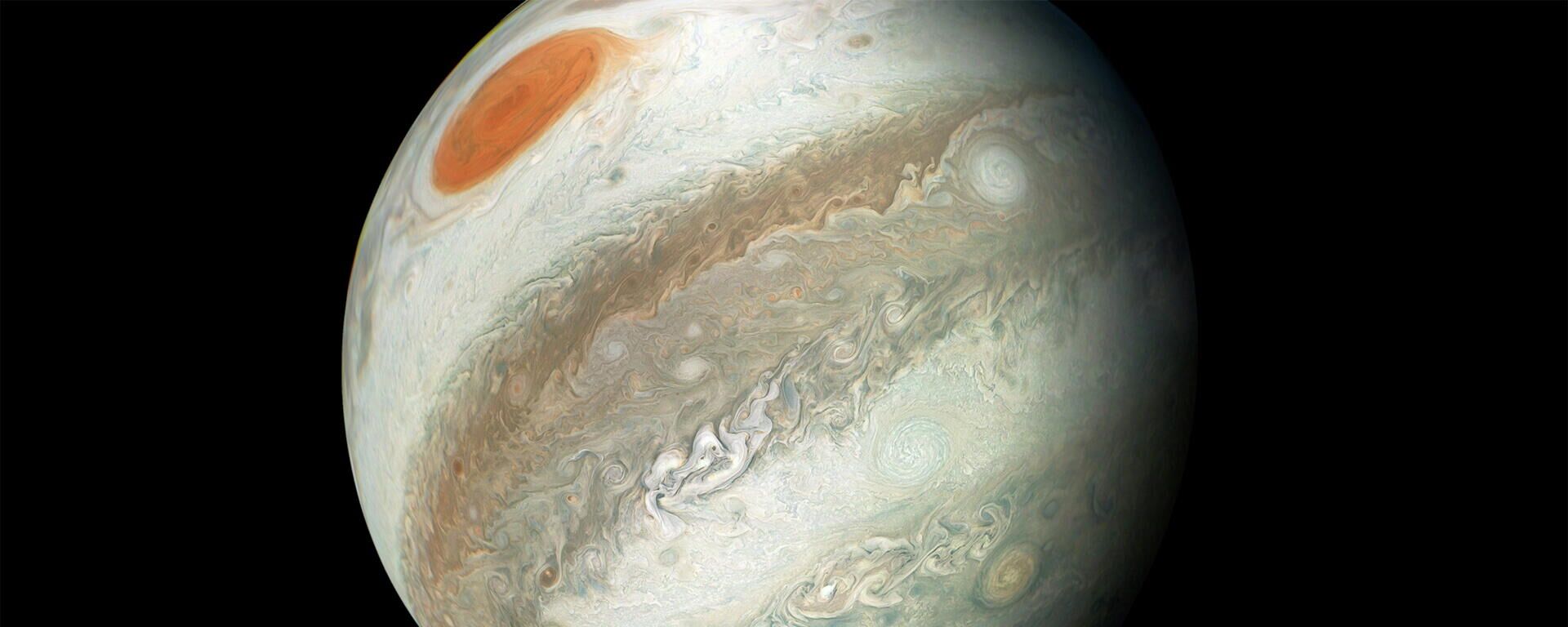https://sputnikglobe.com/20221002/say-goodbye-to-retrograde-jupiters-in----heat-wave--1101426287.html
Say Goodbye to ‘Retrograde,’ Jupiter’s in . . . Heat Wave?
Say Goodbye to ‘Retrograde,’ Jupiter’s in . . . Heat Wave?
Sputnik International
The fourth-brightest object in our solar system, Jupiter is one of only five planets seen with the naked human eye – mostly due to its auroras, or particles... 02.10.2022, Sputnik International
2022-10-02T03:37+0000
2022-10-02T03:37+0000
2022-10-02T03:37+0000
science & tech
jupiter
heat wave
study
aurora
japan's aerospace exploration agency (jaxa)
https://cdn1.img.sputnikglobe.com/img/07e6/09/15/1101025689_0:0:2376:1338_1920x0_80_0_0_693edeb5068b731034068a9d82fed2a7.jpg
Information presented at the most recent Europlanet Science Congress revealed that Jupiter’s auroras, which are permanent, could be providing the extra energy necessary for heating the planet’s upper atmosphere.Scientists realized nearly 50 years ago that something was off about Jupiter’s atmosphere. At roughly five times the distance from the sun than Earth is, it receives only 4% of the solar radiation that reaches Earth. Despite this, the temperature of its upper atmosphere is comparable to that of Earth’s atmosphere.Astronomer James O’Donoghue of the Japan Aerospace Exploration Agency (JAXA), along with his team, was able to produce “the first maps of Jupiter's upper atmosphere capable of identifying the dominant heat sources.”The maps, created at Keck Observatory using state-of-the-art telescopes, allowed scientists to get an accurate look at the way Jupiter’s auroras delivered heating on a planet-wide scale.According to the scientists, Jupiter’s auroras, which form from an interaction between charged particles, magnetic fields, and molecules in the atmosphere – just like the “northern lights “ on planet Earth – are permanent and generated by its moon, Io, which is the most volcanic object in the solar system.According to the research, while the scientists were collecting observations of Jupiter’s auroras, a solar wind collided with the gas giant, enhancing the auroral heating and delivering a significant amount of additional heat to the atmosphere."While the auroras continuously deliver heat to the rest of the planet, these heat wave 'events' represent an additional, significant energy source," O'Donoghue explains.There are other planets that are hotter than they should be, including Neptune, Uranus, and Saturn, and while none of them have auroras in the same size range as Jupiter, this finding represents potential avenues for exploration in the future.The research started a few years ago in Leicester before moving on to Boston University and NASA, ultimately ending at JAXA.
https://sputnikglobe.com/20220623/nom-nom-nom-jupiter-got-so-big-by-gobbling-up-baby-planets-astronomers-say-1096607426.html
Sputnik International
feedback@sputniknews.com
+74956456601
MIA „Rossiya Segodnya“
2022
News
en_EN
Sputnik International
feedback@sputniknews.com
+74956456601
MIA „Rossiya Segodnya“
Sputnik International
feedback@sputniknews.com
+74956456601
MIA „Rossiya Segodnya“
science & tech, jupiter, heat wave, study, aurora, japan's aerospace exploration agency (jaxa)
science & tech, jupiter, heat wave, study, aurora, japan's aerospace exploration agency (jaxa)
Say Goodbye to ‘Retrograde,’ Jupiter’s in . . . Heat Wave?
The fourth-brightest object in our solar system, Jupiter is one of only five planets seen with the naked human eye – mostly due to its auroras, or particles interacting with gases in the atmosphere to create light. Recent findings suggest these auroras may be the key to understanding questions about why the planet is hotter than models predict.
Information presented at the most recent
Europlanet Science Congress revealed that Jupiter’s auroras, which are permanent, could be providing the extra energy necessary for heating the planet’s upper atmosphere.
Scientists realized nearly 50 years ago that something
was off about Jupiter’s atmosphere. At roughly five times the distance from the sun than Earth is, it receives only 4% of the solar radiation that reaches Earth. Despite this,
the temperature of its upper atmosphere is comparable to that of Earth’s atmosphere.Astronomer
James O’Donoghue of the Japan Aerospace Exploration Agency (JAXA), along with his team, was able to produce “the first maps of Jupiter's upper atmosphere capable of identifying the dominant heat sources.”
The maps, created at
Keck Observatory using state-of-the-art telescopes, allowed scientists to get an accurate look at the way Jupiter’s auroras delivered heating on a planet-wide scale.
“We found that temperatures start very high within the aurora, as expected from previous work, but now we could observe that Jupiter’s aurora, despite taking up less than 10% of the area of the planet, appears to be heating the whole thing,” explained O’Donoghue.
According to the scientists, Jupiter’s auroras, which form from an interaction between charged particles, magnetic fields, and molecules in the atmosphere – just like the “northern lights “ on planet Earth – are permanent and generated by its moon, Io, which is the most volcanic object in the solar system.
"These findings add to our knowledge of Jupiter's upper-atmospheric weather and climate, and are a great help in trying to solve the 'energy crisis' problem that plagues research into the giant planets," said O’Donoghue.
According to the research, while the scientists were collecting observations of Jupiter’s auroras, a solar wind collided with the gas giant, enhancing the auroral heating and delivering a significant amount of additional heat to the atmosphere.
"While the auroras continuously deliver heat to the rest of the planet, these heat wave 'events' represent an additional, significant energy source,"
O'Donoghue explains.
There are other planets that are hotter than they should be, including Neptune, Uranus, and Saturn, and while none of them have auroras in the same size range as Jupiter, this finding represents potential avenues for exploration in the future.
The research
started a few years ago in Leicester before moving on to Boston University and NASA, ultimately ending at JAXA.


